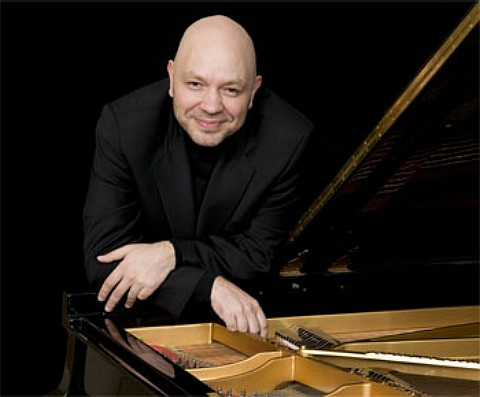
Y ou just have to ‘see’ more music in this music.”T here is a sense of space and gravity... of invisible forces and large-scale coherence in the moves by Midori (五嶋 みどり, Gotō Midori), especially in her performance of the Shostakovich, Op. 134, with pianist Özgür Aydin. It is as though each phrase is a consequence of something more remote than what the immediately preceding bars contained. Her recital tonight was like an expedition...
— Valery Gergiev, regarding Shostakovich’s musical/spatial imagery, quoted by Fanning, p. 77.
- Mozart - Sonata in E-flat Major K.380
- Shostakovich - Sonata Op. 134
- Schumann - Sonata in A minor, Op. 105
- Schubert - Fantasy in C Major, D.934
W hy does this sonata’s first movement evoke Bach for me? And what about the idiomatic ‘jazz’ figures in the piano part, about 2 minutes into the second movement (Allegretto) and about 8 minutes into the third movement (Largo)?
T he phrases are played as if they are in “double quotes”—reporting where they’ve been and what they’ve seen. They have an arresting effect. Are they accurate? Are they really meant by Shostakovich to reference artifacts of our own culture or are they instead a kind of caricature or impostor? Shrewdly constructed by an alien intelligence from outer space and sent to us for some alien purpose? Or is it devised by an empathetic terrestrial intelligence?
T he Allegretto scherzo in E-flat major is impulsive, vehement. The Largo is infused with drama, but it too is mysterious—ambiguous in its direction and tonality and genre... A Bach-like passacaglia that has now returned from outer space, changed by contact with unknown extraterrestrials? (Maybe I should not have had the absinthe before the concert...)
K ristian Hibberd’s 2005 dissertation was the first application of the ideas of philosopher Mikhail Bakhtin to understanding Shostakovich’s music—theories of ‘carnival’ and ‘registers,’ voiced in discourse. Since then, others have likewise found Bakhtin’s concepts helpful (see the Chapters in Part II of Pauline Fairclough’s multi-author edited volume, plus Chapter 6 and the Epilogue in Judith Kuhn’s book, links below). They examine Shostakovich’s musical language, exploring controversies pertaining to the composer’s labile and contradictory meanings.
T hese authors give an account of the diverse interpretations by partisans in the musicological “Shostakovich Wars,” reporting that the Wars have demolished the notion of one, fixed meaning in Shostakovich’s music. Political? Hard to tell for sure whether Shostakovich was a loyal communist or a dissident! Expressions of post-modern subjectivity, filled with various voices, inscribing each other, filled with uncertainty? Hard to tell whose narratives these are!
T o me, Shostakovich’s design in Op. 134 seems prophetic of our current hyperlinked, cross-referential age. In each movement I wonder: Is Shostakovich expounding, or quoting, or inline linking (referring to the expressions of others)? Did the Soviet authorities hold him liable for his musical deep linking? for carnivalizing or caricaturizing or referencing Soviet and Western culture? Do Midori and Aydin?
A nd, 40-plus years after it was composed, how should we feel about these deep-link references? Its gestures are “late-20th Century” through and through, and I wonder how it will be received in 50 years or 100. But I am after this performance impressed by it also as a composition about composing—a ‘meta’ commentary about reporting and referencing and linking. It is that aspect of this music that interests me most. And I wonder whether it is that aspect that will contribute most to this sonata’s continuing attractiveness and relevance in the distant future.
T he ‘inner’ sounsdcapes of writing and reading bear resonance of [and refer to, or link to—] ‘outer’ soundscapes... the world is always full of sounds... they enter and depart in processions as events pass us or as we pass them. This is why the music of the streets has no beginning or end but is all middle.”
— Marianne Ping Huang, ‘Gestures of the Unheard,’ in The Novelness of Bakhtin, p.168.
- Midori website
- Özgür Aydin website
- Shostakovich Op. 134 page at Wikipedia.org
- Deep Linking page at BitLaw
- Supreme Court of Canada, Crookes et al. v. Newton, 2011 SCC 47, 19-OCT-2011. [linking of defamatory material is not defamatory]
- Panez O. Spanish court rules that linking to potential copyright infringing material is not copyright infringement. EFF, 05-AUG-2011.
- Bakhtin M. The Dialogic Imagination. Emerson C, Holquist M, trs. Univ Texas, 1998.
- Bakhtin M. Art & Answerability. Univ Texas, 1990.
- Bakhtin M. Toward a Philosophy of the Act. Univ Texas, 1992.
- Barta P, et al., eds. Carnivalizing Difference: Bakhtin and the Other. Routledge, 2001.
- Blevins J, ed. Dialogism and Lyric Self-Fashioning: Bakhtin and the Voices of a Genre. Susquehannah Univ, 2008.
- Bruhn J, Lundquist J, eds. The Novelness of Bakhtin: Perspectives and Possibilities. Tusculanum, 2001.
- Carpenter E. 'Russian theorists on modality in Shostakovich’s music,' in: Shostakovich Studies, Fanning D, ed. 2e. Cambridge Univ, 2006.
- Fairclough P, ed. Shostakovich Studies 2. Cambridge Univ, 2010.
- Fanning D. 'Shostakovich and structural hearing,' in Shostakovich Studies, Vol. 2, Fairclough P, ed. Cambridge Univ, 2010.
- Fay L, ed. Shostakovich and His World. Princeton Univ, 2004. (pp. 309-10, 344, 348)
- Haynes D. Bakhtin and the Visual Arts. Cambridge, 2008.
- Hibberd K. Shostakovich and Bakhtin: A Critical Investigation of the Late Works (1974-1975). PhD dissertation, Univ London, 2005.
- Holquist M. New Accents: Dialogism: Bakhtin and His World. 2e. Routledge, 2002.
- Jones M. Dostoyevsky after Bakhtin: Readings in Dostoyevsky's Fantastic Realism. Cambridge Univ, 2005.
- Kuhn J. Shostakovich in Dialogue. Ashgate, 2010.
- Midori G. Einfach Midori. Henschel, 2004.
- Morris P, ed. The Bakhtin Reader: Selected Writings of Bakhtin, Medvedev, Voloshinov. Hodder-Arnold, 2009.
- Rzhevsky N, ed. The Cambridge Companion to Modern Russian Culture. Cambridge Univ, 1998.
- Salzer F. Structural Hearing: Tonal Coherence in Music. Dover, 1962.

No comments:
Post a Comment